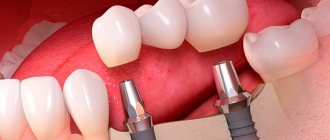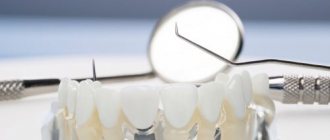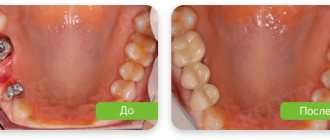In an era of huge information flow, it can be difficult for a person to distinguish truth from fiction or an existing stereotypical opinion, moreover, a subjective one. Implantology is also not ignored. Such a number of rumors, distorted facts and simply fiction that implant surgeons are faced with is probably not found in any other medical field. Myths about dental implants are breaking records.
Fear of surgery forces patients to listen to various rumors and stories about the terrible consequences of treatment. However, all these horror stories are based on outdated data or have no basis at all. In this article we will debunk the most common myths and tell you why implantation is the most physiological, aesthetic and reliable option for dental restoration.
MYTH 1: Getting an implant is painful.
Implantation is the surgical insertion of an implant into the jawbone to replace the missing tooth root. Like any other invasive dental procedure, implantation is performed under anesthesia. Considering that bone tissue has no pain receptors at all, the process of installing and engrafting an artificial root is painless. After the intervention, unpleasant sensations may occur (minor pain, swelling of the gums), but this is a natural reaction of the body, which passes without consequences and is controlled by the usual painkiller.
Implantation price
The cost of installing a dental implant depends on many factors, such as the type of implant, the material and manufacturing technology of the crown, and a number of other factors.
You can see prices for dental implantation in our price list
How much does it cost to install an implant?
| No. | Name of service | Price |
| 1 | The operation of installing one premium implant “SLActive” from Straumann | 38,000 rub. |
| 2 | Installation procedure for one Alpha Bio implant (including plug) | 24,000 rub. |
| 3 | The operation of installing one premium implant “NEO” from Alpha Bio (including a plug) | 27500 rub. |
| 4 | Installation procedure for one DIO implant (including plug) | 17250 rub. |
Implantation and pain
Every patient is concerned about the pain that accompanies the implantation process. Implant installation, like any surgical procedure, is performed under local anesthesia.
After implantation (installation of an implant) of teeth, slight swelling and pain may occur, which disappear within a few days. The doctor gives recommendations. Engraftment of the implant does not cause any discomfort.
The gum former is also installed under local anesthesia.
MYTH 3: Implants often fail
Outdated disc and plate implant models caused many problems for patients due to complex, traumatic fixation into the bone. They did have a high rejection rate (50%). Such models have not been used for a long time, but the stereotypical opinion remains. The latest generation implantation systems are made from biocompatible, hypoallergenic material (medical titanium, zirconium oxide). Thanks to the root-shaped shape of the implant, similar to the anatomy of a natural tooth root, and a special active coating, successful engraftment is ensured in 98-99% of cases.
MYTH 4: Implantation takes a long time
Of course, dentistry has not yet learned how to grow new teeth instead of missing ones in one day, and treatment will take some time. As for the procedure itself, it takes less than an hour. From the initial consultation to the installation of the prosthesis, it can take 6-12 months, sometimes more. But this does not mean that you will need to go to the dentist every day all this year. Implantation takes place in several stages, each taking a minimum of time. The longest is the fusion of the implant with the bone (osseointegration). This process lasts about 3-6 months.
Implantation of 1 tooth
The technique involves surgical intervention, which requires a careful approach at all stages. The number of doctor visits, the need for certain procedures and the duration of engraftment vary from person to person.
1
2
3
4
5
6
The diagnostic stage includes examination by a therapist, radiography (assessment of the condition of the bone, root systems of adjacent teeth), CT or tomography (assessment of bone density), orthopanorama (position of elements), consultation with a therapist and, if necessary, specialists (ENT, allergist, cardiologist, endocrinologist) .
Preparation includes sanitation of the cavity, treatment of all diseases of the dental system, and removal of elements unsuitable for restoration. Implantation is performed only on healthy patients. Colds, allergies, herptic rashes and other acute conditions can provoke rejection of the installed structure and the appearance of complications.
Bone grafting is performed when natural bone volume is lost. It is performed in several ways depending on the nature of the problem.
The surgical stage takes no more than 30–60 minutes and includes several manipulations:
- anesthesia;
- incision of the braid to access the bone;
- bed formation;
- installation of a titanium rod;
- suturing.
Osseointegration, or engraftment, into the bone takes from 3 to 6 months, depending on the location (lower or upper jaw) and the personal characteristics of the organism.
Preparing the site for installing a crown - installing a gum former. It is an intermediate stage and is carried out 3-5 months after surgery. Recovery takes 2 weeks.
Abutment fixation, impression taking, crown installation. Several fastening methods are used (adhesive material, built-in locks or screws).
If the decayed tooth or its root is not removed at the time of implantation, then a one-stage surgical protocol is possible. In this case, immediately after removal, an implant with an abutment is installed. This option is the least traumatic, as it involves only one operation. An added benefit is the preservation of gum contour for a natural-looking smile.
Possible implantation with immediate loading, when a temporary crown is installed in the smile area.
The rehabilitation period involves strict adherence to doctor's orders, restrictions on exercise, nutrition, visiting saunas and rinsing with antibacterial sprays. Discomfort and minor soreness may persist for some time.
Doctors at the Vimontale clinic use the latest implantation methods that meet the needs of patients and their financial expectations. Implantologists undergo regular training and advanced training, which allows them to work with the most complex cases with confidence in successfully solving the problem. Sign up for a free consultation and get answers to all your questions about the cost, timing and scope of the required work.
Collapse
MYTH 5: Until the implant takes root, you will have to walk around with a hole in your mouth
Modern implantology has solved this problem. Innovative methods of prosthetics on Immediate Load implants make it possible to eliminate the wait during the implant healing period and to carry out prosthetics immediately after the intervention (within 72 hours). For prosthetics, lightweight orthopedic structures made of metal-plastic are used. This allows the patient not to experience discomfort due to missing teeth. The temporary prosthesis is replaced with a permanent one after complete engraftment of the artificial root. With classic two-stage implantation, the aesthetic deficiency is compensated with the help of a removable immediate prosthesis (butterfly) and adhesive (suspended) crowns.
What is included in the total cost of dental prosthetics?
When installing a denture, the patient has to bear basic and additional costs. The following require separate costs:
- diagnostics of the dental system using radiography;
- treatment of identified dental diseases;
- preparing teeth for prosthetics (depulping, grinding, removal);
- taking impressions or using a computer modeling method;
- installation of temporary prosthetic structures;
- making permanent crowns or bridges in the laboratory;
- fitting, adjustment, installation of prosthesis.
If prosthetics on artificial roots is used, then the total cost of treatment also includes the cost of implantation.
MYTH 6: Implants are very expensive
The cost of implantation is more expensive than classical prosthetics, this is a fact. But if you consider in the long term, installing an implant will cost less than a traditional fixed bridge:
- The artificial root is implanted for life; only orthopedic structures are subject to replacement. The average service life of a classic metal-ceramic prosthesis supported by natural teeth is about 5-6 years, and supported by implants - 10-12 years.
- Manufacturers offer implantation systems in different price categories, among which it is easy to choose the optimal option in terms of quality and price.
- When replacing a classic prosthesis, retreatment of supporting units is often required, which increases the cost of reprosthetics.
- Since the main chewing load falls on the supporting teeth, the bone under the prosthesis begins to atrophy, the gums sag, which requires correction of the orthopedic system. This also affects the price.
Based on all of the above, implantation in the long term turns out to be more financially beneficial than traditional prosthetics.
MYTH 10: An implant can be installed on the same day of treatment.
Many patients are misled by the phrase “one-day implantation.” In fact, it involves restoring teeth using one-stage implantation methods with immediate loading of the prosthesis. Basal or one-stage technology allows you to restore missing teeth in a few days, even with severe bone atrophy. This became possible due to an integrated approach and the installation of artificial roots in the deep bicortical bone layers. Also, treatment time is reduced by loading the implants with a prosthesis almost immediately after surgery.
But one-stage protocols, like classical two-stage implantation, require preliminary preparation, including:
- Comprehensive diagnostics (X-ray examination, tests);
- sanitation of the oral cavity - removal of dental deposits (plaque, tartar), treatment of teeth and gums;
- eliminating existing obstacles to surgical intervention.
Without quality preparation, implantation is impossible. A reliable dental clinic is guided by the rule of professional responsibility and will never perform surgery without a full diagnosis, drawing up a treatment plan, and simulating the course of the operation. This is the diagnostic obligation of the doctor and he vouches for it. But myths about dental implants exist and will always exist; the main thing is to know them and evaluate them reasonably.
What is a dental implant?
It is a common misconception among patients to call an entire artificial tooth an implant. This is wrong. A dental implant is a metal (titanium) rod of a special complex shape, which is installed in the patient’s bone and performs the function of a tooth root – i.e. transfers loads from the crown of the patient's bone tissue. It is the implant that holds the entire structure.
The implant is selected by an orthopedist and a surgeon based on the individual condition of the patient’s bone tissue, as well as taking into account many other factors, such as the presence of concomitant diseases, or, for example, bad habits of the patient.
The visible part of an artificial tooth (as well as a natural tooth) is called a crown. The crown is made from various materials and using different technologies. The crown must be strong and not differ from the patient’s neighboring natural teeth.
At the Shumakova clinic we make crowns using the most modern technologies, using computer modeling and manufacturing the crown itself from modern ceramic materials!
Read more in the section “Metal-free ceramics”
The third component of an artificial tooth is the abutment. This is an unfamiliar word to most patients. The abutment is an intermediate link between the ceramic crown and the metal implant.
How implantation usually occurs:
1. A joint consultation between a surgeon and an orthopedist is carried out. Doctors analyze the image in detail and determine a work plan.
2. A dental implant is installed. A titanium dental implant without an abutment and crown is installed in the prepared gum. Instead of a crown, a special plug is installed. The gum above the implant is sutured and the implant healing process begins.
3. The gum former is installed. 3-6 months after installation of the implant, its engraftment is completely completed and it can already take the chewing load. The plug is removed from the implant and a gum former is installed in its place. It allows you to form the desired shape of the gums before installing a crown.
4. Installation of an artificial crown. Two weeks after installation, the gum former is removed and an abutment and an artificial dental crown, made in exact accordance with the shape and color of the patient’s surrounding teeth, are installed in their permanent place.
This is what the classic two-stage implantation process looks like. As you can see, the complete installation of a dental implant is a rather lengthy process. The longest part of which is the engraftment of the titanium implant.
Where to go for dental implantation in Moscow
The Ilatan Clinic in Moscow is one of the few where all modern, proven implantation protocols with immediate and delayed loading are used. The clinic’s doctors will select treatment taking into account the condition of the jawbone, aesthetic requirements, functionality of the dentition, and the patient’s financial capabilities. Implantation is performed on a turnkey basis, which protects against unexpected expenses. After a comprehensive diagnosis, the doctor will offer several treatment options - you can think about it and make an informed choice. All implantology services are guaranteed.











